Over the last year, we’ve worked with some companies that have younger domains, and we’ve come up against some challenges that we hadn’t had before with previous clients.
Specifically:
- It’s taken longer to get blog posts ranking anywhere on the first 10 pages of Google (we normally see rankings within the first few months)
- As a result, organic traffic was slow to come by in the first 3-6 months
- Many of these younger domains had blogs on subdomains instead of subfolders
One client that had all three of those challenges (and is the focus of this case study) was Circuit.
We started working with them in February of 2020 and the first 4-6 months were stressful because we were using our content marketing process as normal but weren’t getting results as quickly as we are used to.
Organic traffic to our blog posts looked like this for the first 5 months.
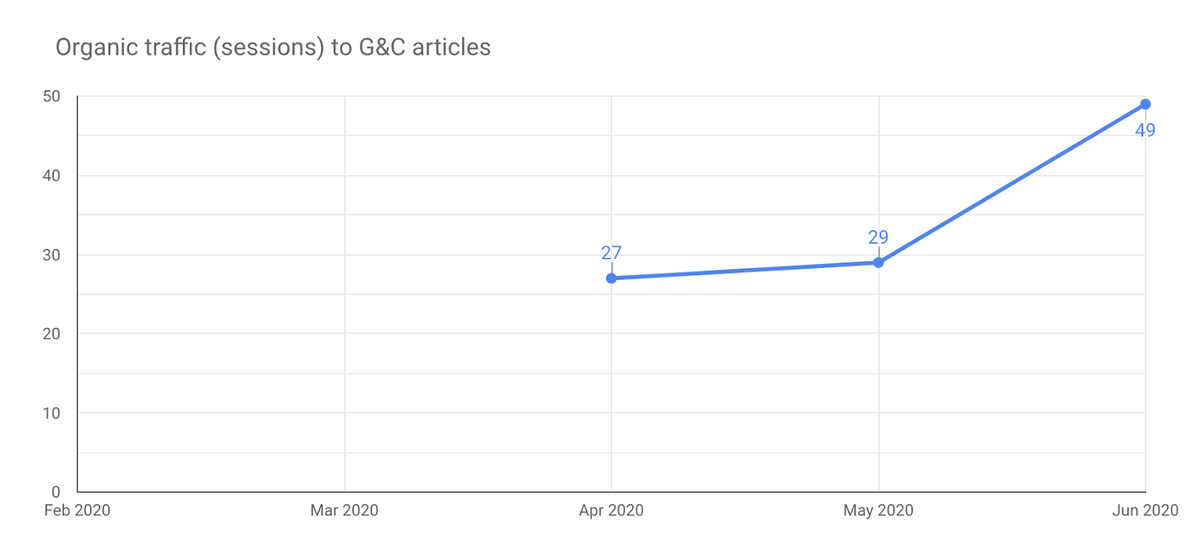
Not good.
Then, in September 2020, I tweeted this:
This account gave me lots of sleepless nights. For what felt like forever, we couldn’t get articles to rank.
— Benji Hyam (@benjihyam) September 23, 2020
Then in June, we felt like the issue was the blog being on a subdomain. It got moved to /blog/.
3 months later… we finally have liftoff.
Trust the process. pic.twitter.com/iqmVTUw3Pv
I tweeted that because there’s a moment with every client where we can feel that the process is finally clicking and everything is falling into place — and it’s only a matter of time before results start scaling quickly.
Since that tweet on September 23, 2020, results have continued to climb. Circuit’s conversions have increased 313% (from 59 to 244 trial signups) and organic traffic has increased 1484% (from 920 to 14,577 sessions) in a ~6 month period ending Mar, 31, 2021.
Those large percentage increases are mostly a function of starting with small numbers. The point isn’t what the actual number is, but rather how quickly organic growth can happen once all of the articles in our content marketing process start to come together. Here is the organic traffic generated from our blog posts for Circuit since we started working with them (we’ll show conversion graphs later in the post):
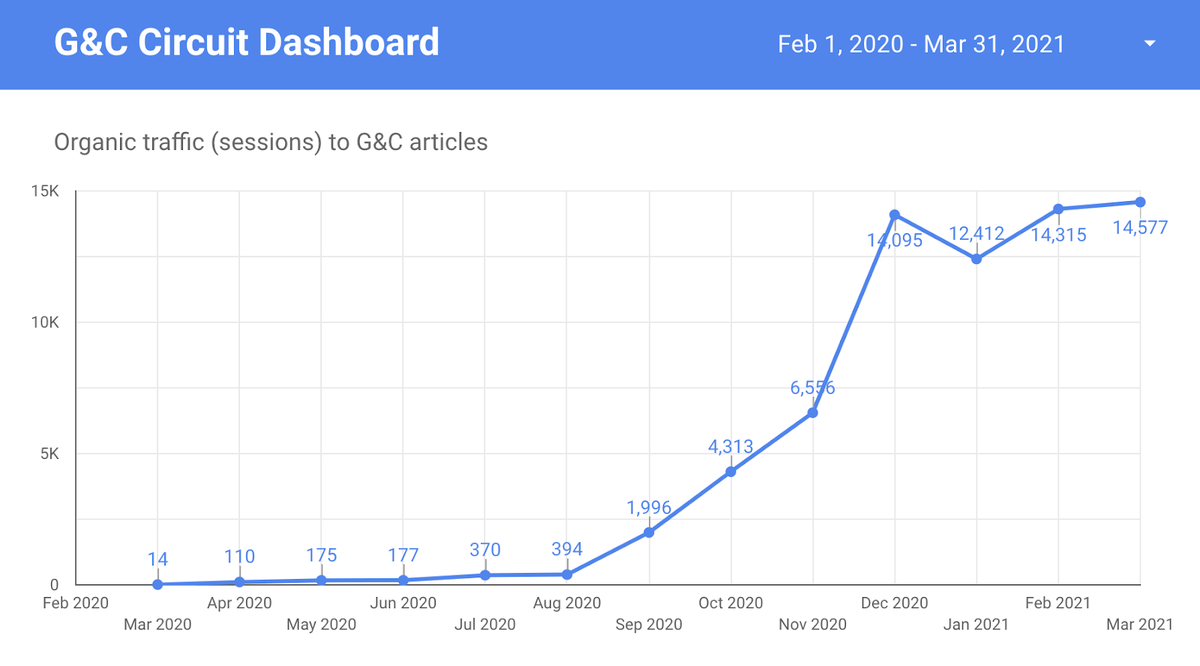
In this piece, we’re going to discuss some of the SEO learnings that came from this account, how we scaled traffic and conversions for Circuit, and the content strategy that helped them grow this quickly in a year.
Our hope is that this case study will be useful for anyone starting content marketing with a younger domain or one with similar technical SEO issues.
Shout out to Matt Goolding and Olivia Seitz on our team who have been the content strategists working with Circuit.
The Content Marketing Challenge Circuit Brought to Us
Jack Underwood, Circuit’s CEO, reached out to us back in February 2020 with a challenge. Their company had grown mainly through paid acquisition (Google Ads) and he wanted to start building his organic presence to take his reliance off paid.
At the time, Circuit’s main product was the Circuit Route Planner, which is an app to help couriers plan their routes and deliver packages faster. But they had also just validated and grown a small customer base for their new Teams product and they wanted to grow that too.

Our #1 goal with every client is to get financial ROI on their spend with us as soon as possible. So because Circuit’s Teams product has a higher plan size, leads we got for Teams were more valuable and thus it made more sense to focus our efforts there — and that’s what we did.
The 2 SEO Challenges We Came Up Against
There were two main challenges we faced when we started working with Circuit:
1. They had a low domain rating
2. Their blog was on a subdomain.
How to Do Content Marketing When the Site Has a Low Domain Rating
When we first started working with Circuit, their site had an Ahrefs domain rating of 18. That’s relatively low compared to most companies we typically work with (usually somewhere between the 30-60DR range).
Domain Rating is a proprietary Ahrefs metric which runs from 0 – 100 on a log scale that, according to them, reflects “the strength of a target website’s total backlink profile (in terms of its size and quality).” As Tim Soulo explains in that post, there’s no hard and fast rule around having a certain domain rating number to get content to rank, since Domain Rating is a measure of the strength of a site’s backlink profile.
In general, the lower the score is relative to other sites in the SERPs for the same keywords you’re going after, the harder it’s likely going to be to rank relative to them. There are other factors that play into this as well, as the Ahrefs post above outlines, but this is just a simple way to think about it.
Finally, we should mention other SEO tools (e.g. Moz, SEMRush) also have similar proprietary metrics that in general do the same thing — measure relative SEO strength of websites, in particular their backlink profiles, on a simple 0 to 100 scale — and the lessons in this case study would apply just fine if you use one of those.
Here is Circuit’s Domain Rating graph in Ahrefs (all time). Remember we started working with them in February 2020.
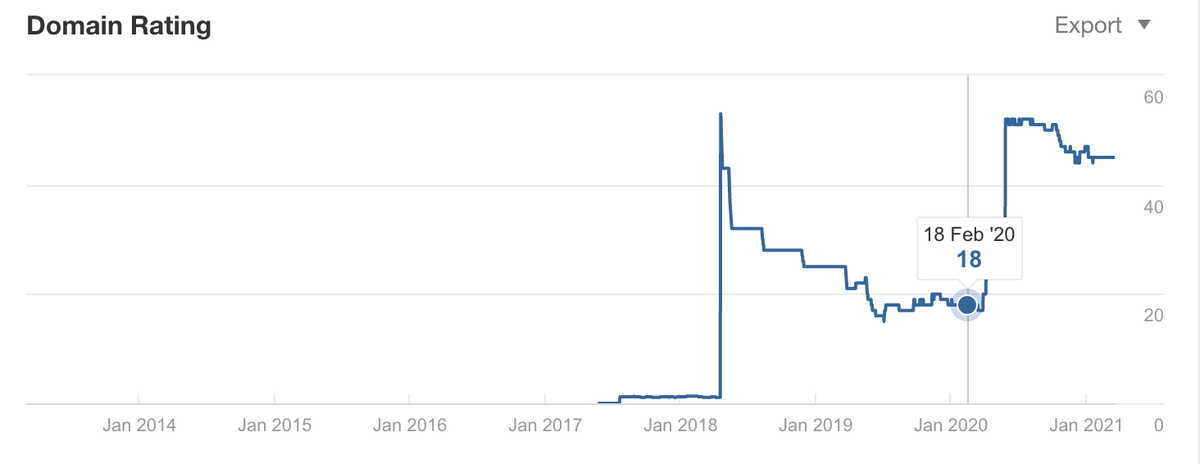
From a content strategy standpoint, there are two things that we did differently here than what we would normally do on a stronger site.
- We focused on pain point SEO content ideas that had varying levels of competitiveness to try to see if we could rank for less competitive terms much faster than some of the more competitive ones, even if the less competitive terms had much lower estimated monthly search volume.
- We tried to come up with ideas that would do well both via paid content promotion and SEO being we didn’t know how long it was going to take for SEO traffic to kick in and we felt like getting conversions through paid would help short term performance while waiting for SEO traffic.
To drill in further on point one, in the beginning of working with them, we had the benefit of having some Google Ads keyword conversion data to base some early decisions off of — specifically, we could see what keywords were already converting for them via Google Ads. Obviously if we could rank for those terms organically, that means we’d also likely get conversions. So we identified 6 topics that we thought would convert well with varying levels of keyword difficulty and we started producing those pieces of content.
On point two, we tried to create more paid social friendly content that we thought would resonate with their target audience even if it wasn’t aimed at ranking for an SEO keyword. For example, we created this article “How to add local delivery to your small business during covid-19” as the Circuit team said they were getting increasing demand for a new use case – small business deliveries at the onset of the pandemic. We thought a piece like this could do well on social media if we could get it in front of small business owners to try to show off a new use case for the product.
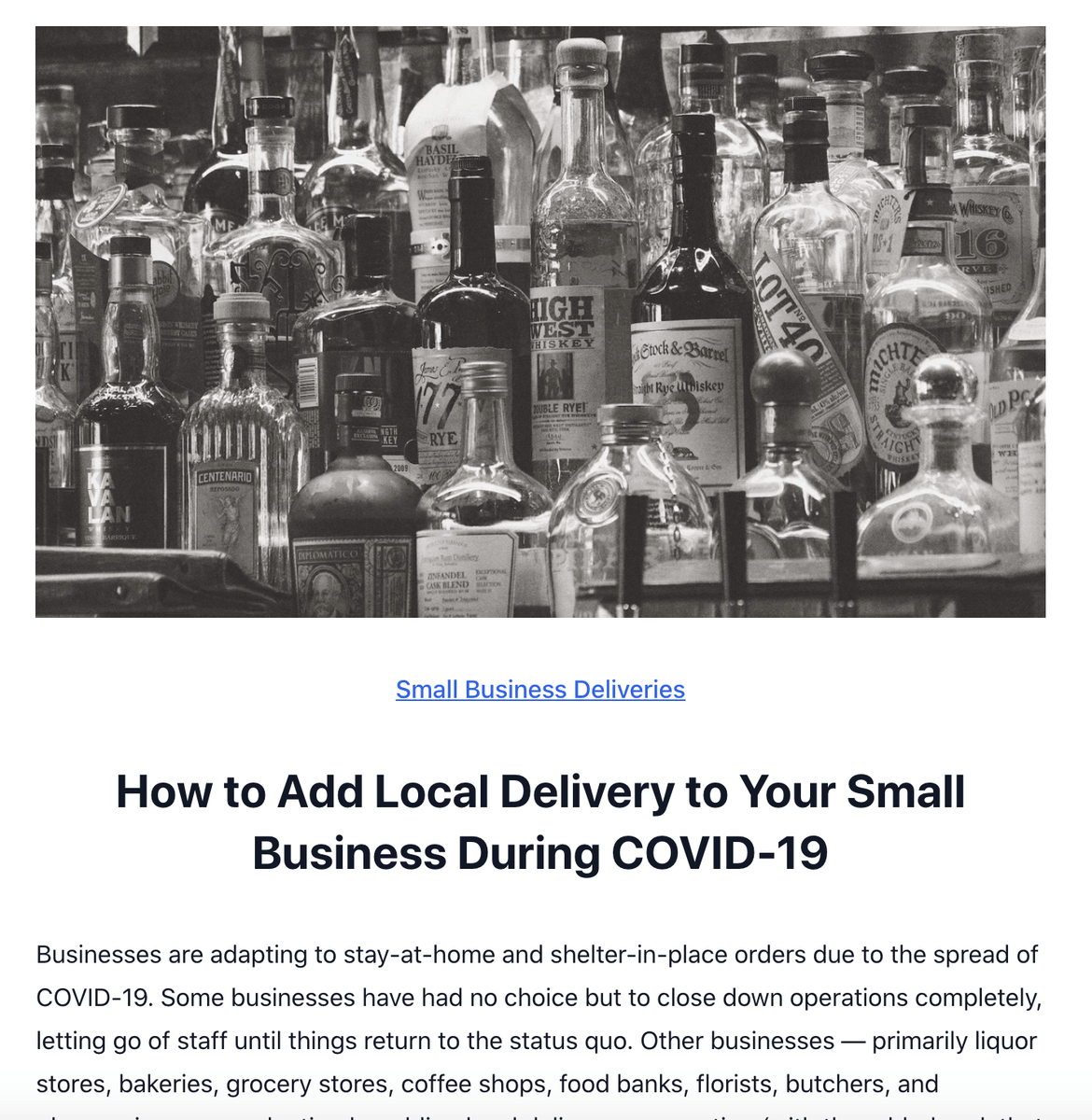
Early Results and Noticing a Red Flag in SEO Results
The paid hypothesis (point 2) ended up playing out as we hoped and we saw not only traffic, but conversions (signup for their teams product), coming from paid promotion of the articles we created specifically for this channel. This was great.
As for our SEO results (point 1), we were having a harder time ranking for the keywords we were going after and we didn’t see any organic conversions in the first four months (which is rare for us).
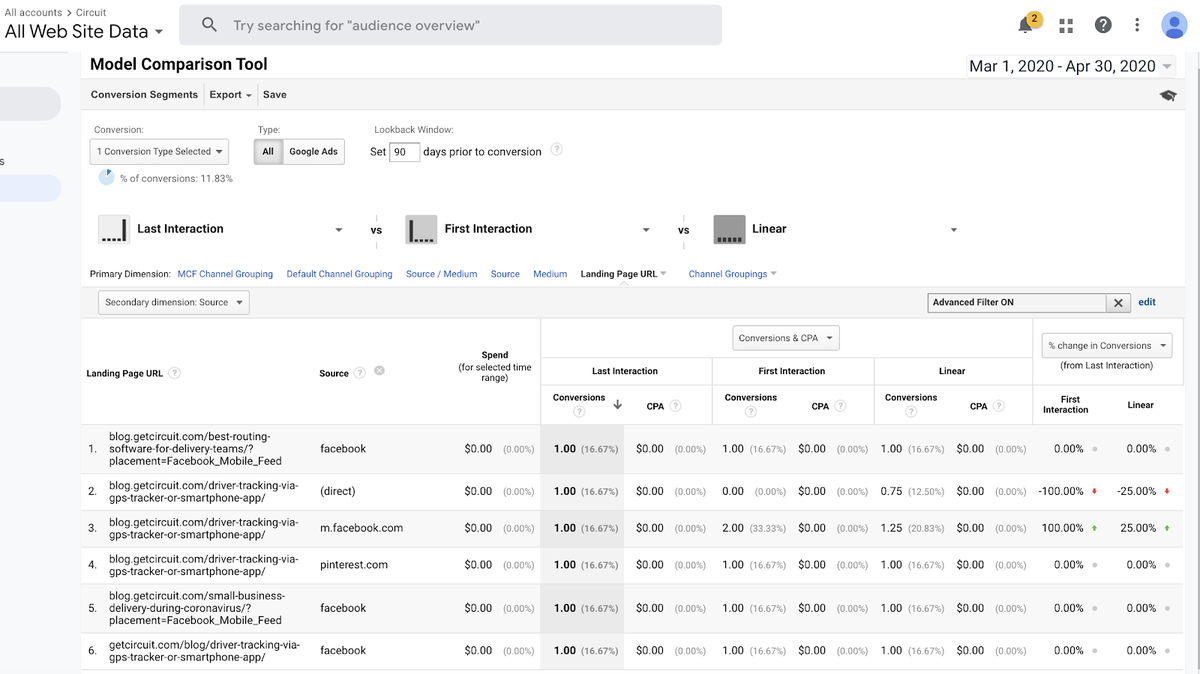
I had mentioned above that there’s a “magic moment” that happens on every account where you can see it’s only a matter of time before everything in our process finally starts to click. To clarify what that magic moment is, it’s when we see our articles start to get indexed by Google and start to rank for the keywords we’re targeting in the top few pages.
Not seeing articles show up in the rank tracker for months is what caught our attention that something was wrong. When we pulled up the Ahrefs rank tracker, the tool that we use to track our SEO rankings, there was only one article that was showing up in any of the top 100 spots. The rest of our articles didn’t even seem to be registering with Google at all: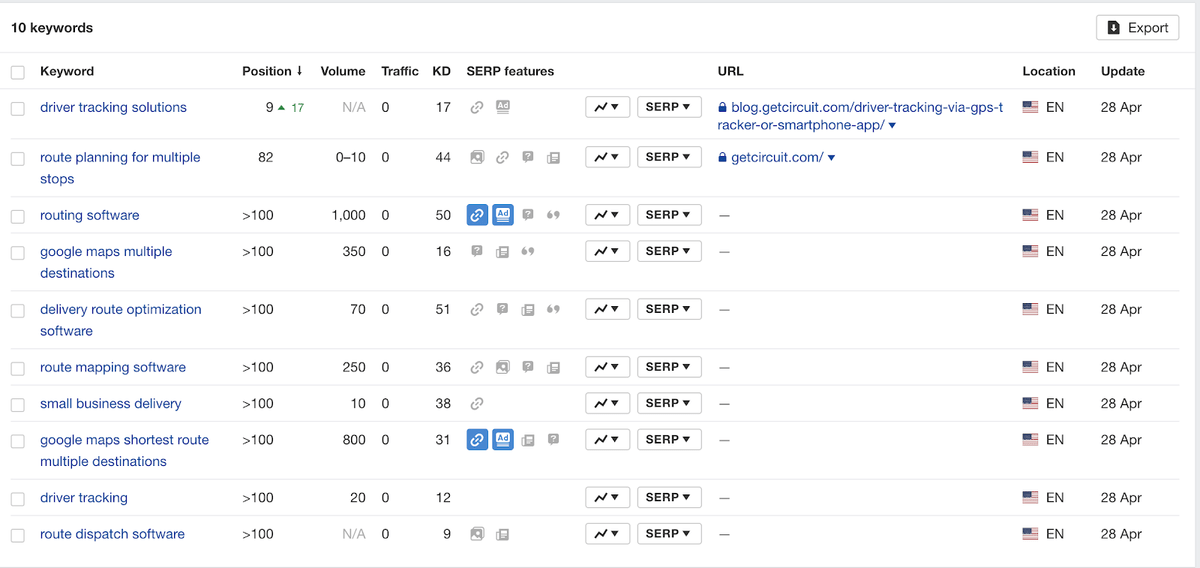
This is extremely unusual. Having blog posts be far from page 1 — page 3, 5, 7 — is fine, as they’ll work their way up over time, but having all of those posts show up as Position “>100” was a red flag.
Identifying the Subdomain as the Issue That Was Causing SEO Results to Lag
Just a couple months into the engagement (around April 2020), the team at Circuit needed to move their blog back to a subdomain for product reasons and before they had done that, we started to see our articles being indexed for the keywords we were targeting. But fast forward a month later (May 2020), articles that were previously ranking on page 1 moved down positions and/or fell out of the top 10 pages in rank tracker.
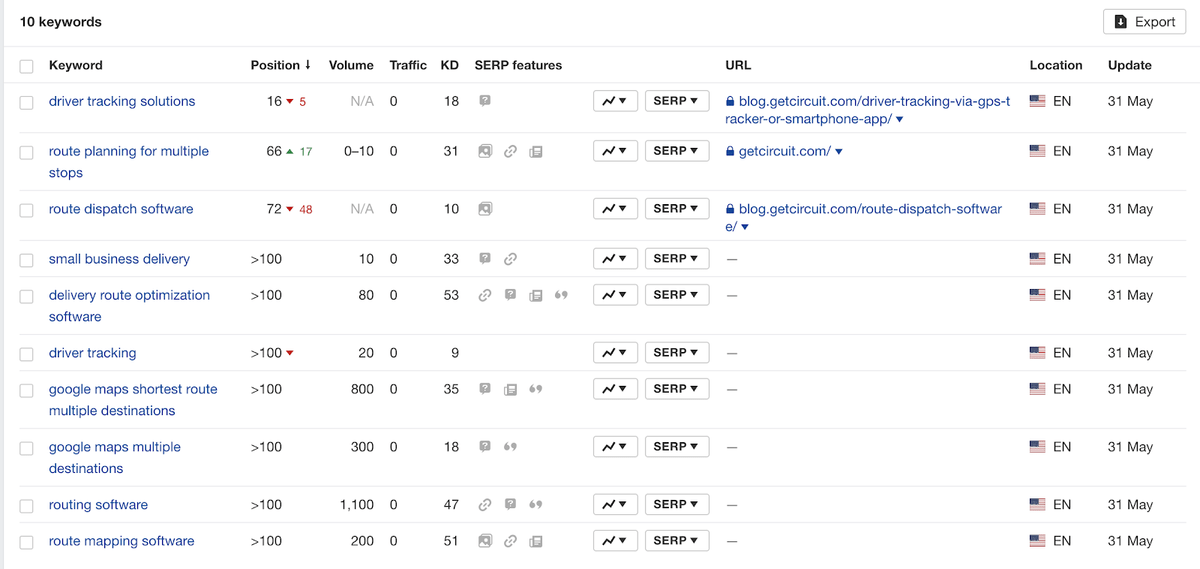
If you’ve read the SaaS content marketing case study that we did with Leadfeeder, then you’ll know that we saw SEO results increase massively when the blog moved from a subdomain back to the parent domain.
Because of that experience and having seen some of the rankings being indexed prior to the move to the subdomain, we thought that it might be the cause of the issue for the slow SEO results.
Fixing this immediately is really important to us, because when you have many pieces published but they’re not ranking anywhere, the organic traffic graph you have to present to the client looks like this:

It’s extremely nerve-racking to show up to a monthly client call with an organic traffic graph like that.
As a related aside: This is why we use a combination of distribution tactics that focus on both short term channels (paid ads) and long term channels (SEO and link building). So while organic traffic was slow to come by, at least we were showing higher overall traffic growth (below) and conversions (graph at the beginning of this article):
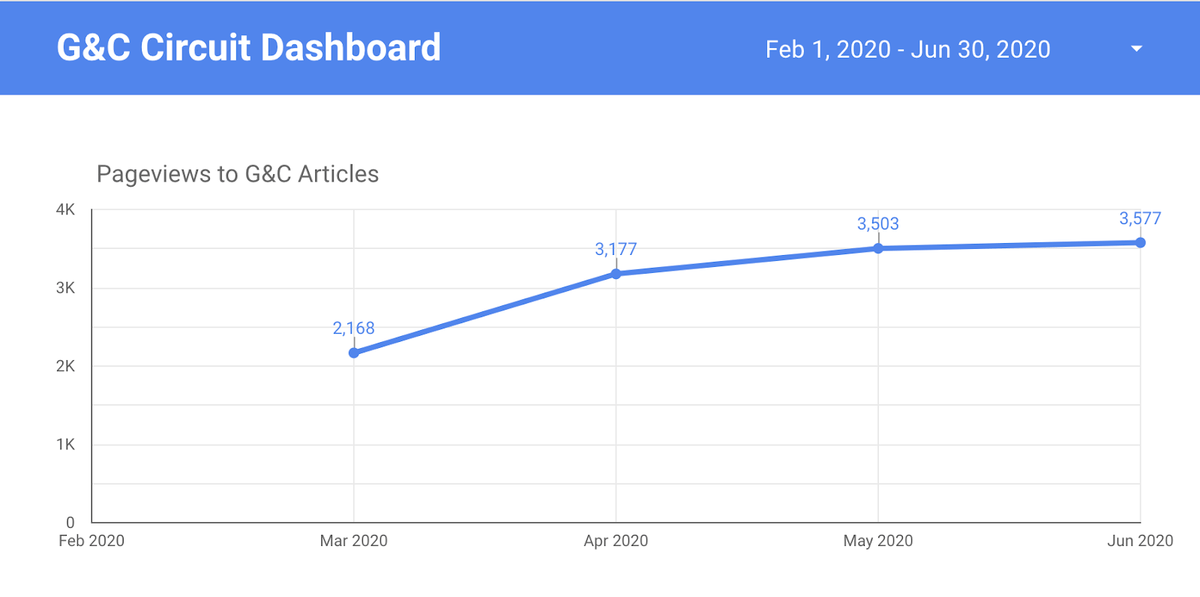
That said, what causes us stress is when we don’t start to see early signs of organic growth working. Because we know long-term SEO traffic and conversions are what lead to the compounding growth effect from the content marketing channel. So without it, it’s going to be extremely hard for us to hit our ROI goal.
We had an honest conversation with Jack and told him that based on some previous things that we had seen, we thought the blog being on the subdomain might be the cause of the slow results. Fortunately, Jack and his team have a long-term mindset and knew that if we could solve this puzzle, we could unlock organic as a channel and that would yield massive ROI.
In June 2020, Jack and the Circuit team moved the blog back from a subdomain to a subfolder, and right away, we started seeing signs of life on the rankings front.
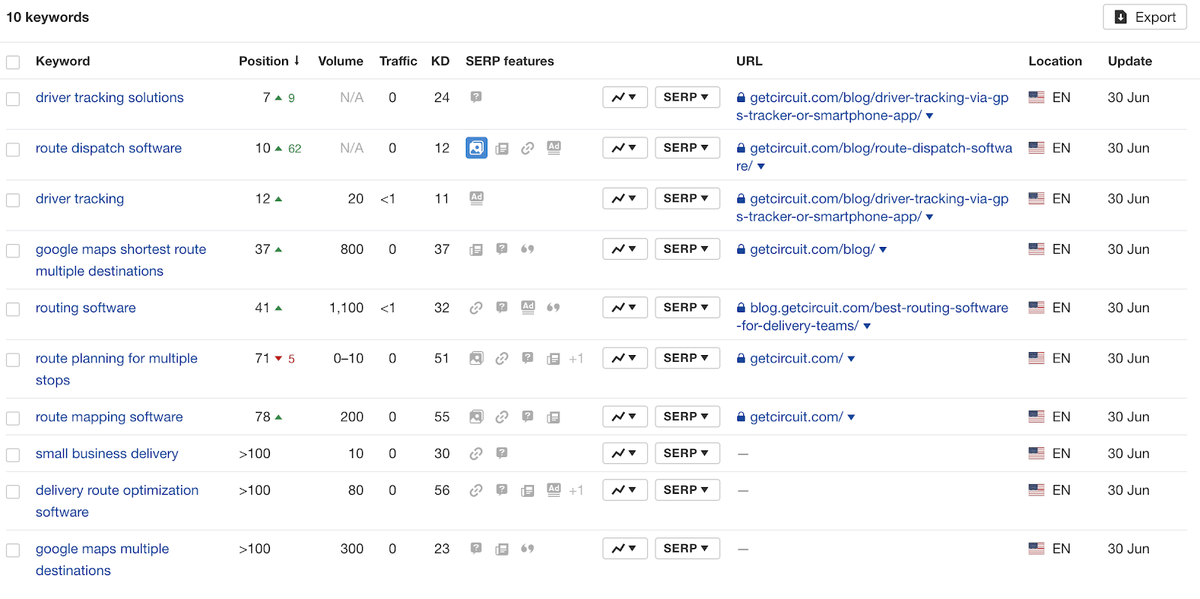
Here is the “average position” graph of the keywords we are tracking for Circuit in Ahrefs:
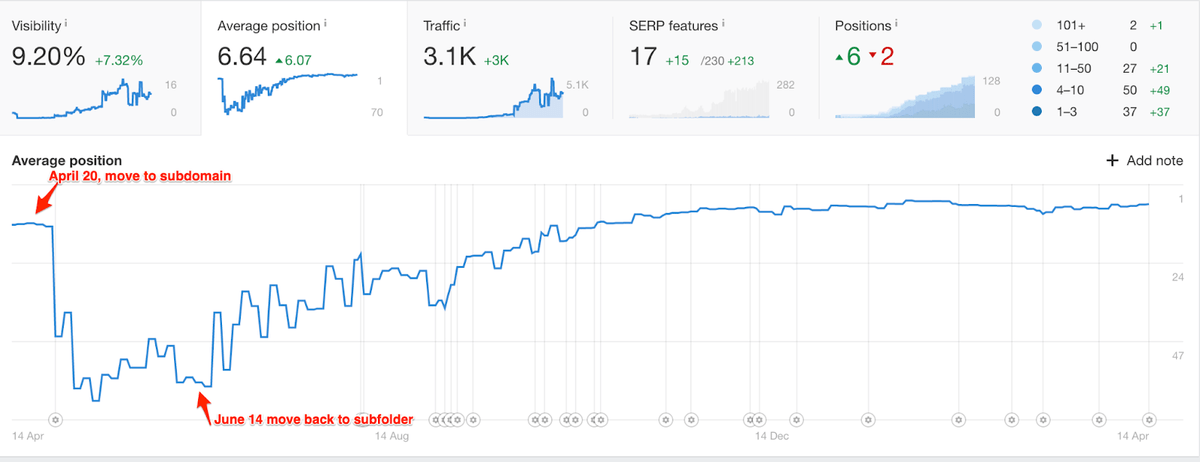
Excuse the tiny date labels at the bottom but the low point is at the end of May, where the average position was > 50 (y-axis is on the right). The blog was moved to a subfolder June 14, and you can see the average position of keywords we were tracking (the ones our blog posts were targeted towards) made a steady climb after that.
Scaling SEO Traffic and the Power of Compounding Growth
After we started to see rankings show up, we knew we were off to the races.
From there, our strategy consists of trying to identify as many variations of bottom of the funnel terms as possible and then working our way up the funnel.
At this point in our engagement with them, we’ve exhausted almost all of the bottom of the funnel terms and are now focusing on the middle and the top of the funnel.

We now rank in position 1-3 for 39 different keywords that we targeted for our articles (92 keywords on page 1 of Google) and many more keywords that we didn’t specifically target.
Over the last 6 months, traffic has scaled to 14,577 organic sessions per month.

Note the time gap between moving the blog to a subfolder (June), then seeing rankings show up (July, August, in the average position graph above) then seeing a big jump in organic traffic in this graph (September). Content and SEO takes patience.
You can see a similar increase in conversions (trial signups for the teams product) around September 2020, about 3 months after the blog was moved to a subfolder. The increase corresponds almost perfectly with the bump in organic traffic:

This correlation between conversions and organic traffic is something we see across many clients: even though paid and other types of content promotion tactics can yield conversions, the majority of content conversions comes from ranking organically for bottom of the funnel keywords.
Note: If you’d like to learn our content strategy and apply it to your business, we teach everything we do in our content marketing course and community.
Conversions from Low Volume Keywords
Finally, we mentioned towards the beginning that one key SEO strategy we use for lower domain rating sites is to go after lower competition keywords that still have good conversion intent (are “bottom of the funnel”) even if they are low volume.
The low volume part is key. Many clients worry at the start of our engagement that we are going after terms that show low volume on SEO software like Ahrefs or Clearscope.
But if you have a good conversion rate, it still works. For example, here are conversions from a few articles in March for Circuit.
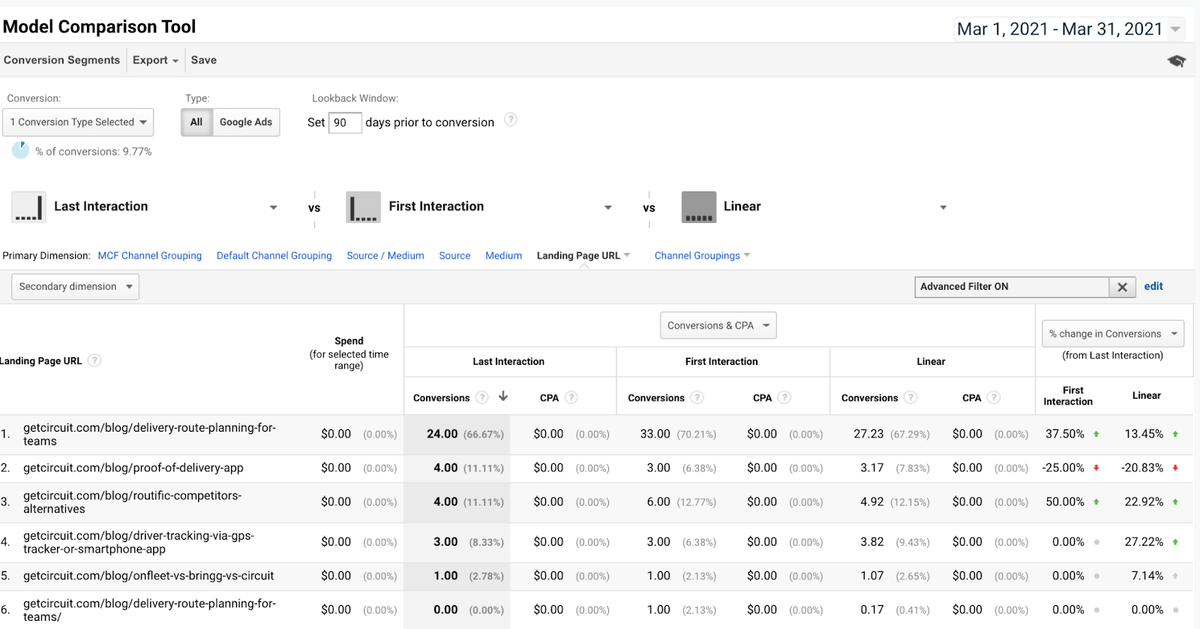
The third row (“/routific-competitors-alternatives”) shows 6 first click conversions. But both “routific competitors: and “routific alternatives” have “0 – 10” volume in Ahrefs


Clearscope shows them with 10 searches per month:


How can a keyword with almost no search volume get 6 conversions per month?
From what we can tell, these monthly search volume estimates are exactly that, estimates. And for competitor keywords like this, they are almost always under-estimated. If you went by those estimates above, you may think:
“Even if we rank #1 and get 30% of the clicks for those keywords, that’s 3 clicks a month for ‘routific competitors’ and 3 more for ‘routific alternatives’, totalling 6 visitors a month. Not worth it!”
But here is the traffic to that post in March (we rank #2 for both terms):

It gets 80 pageviews, 71 of which are organic. Clearly those estimates are off.
In addition, almost anything you publish will rank for a variety of long tail terms that individually may have no volume but together make up the majority of searches on the web. So it could also be that even if those two target keywords don’t have much volume, a bunch of harder to identify long tail terms around those topics have enough volume in total to get way more than 6 pageviews to our post.
Finally, we should mention that competitor keywords like this one have done incredibly well for us with a variety of clients. They are low competition and extremely high search intent. Six conversions in march for routific competitors from 80 pageviews is a beautiful 7.5% conversion rate from a single blog post!
Key Lessons for Anyone Doing SEO and Content Marketing for a Young Domain
- Make sure your blog is on the parent domain instead of subdomain. Although Google has always publicly said subdomain doesn’t matter, we’ve seen this kind of massive improvement in SEO rankings and organic traffic in multiple clients now when moving their blog from a subdomain to a subfolder on the main domain
- Monitor your rankings movements on a weekly basis. Use a rank tracker of any type and look weekly to see how your pages are ranking for target keywords. If they aren’t showing up anywhere on the first 10 pages in a couple months after publishing, that is a sign there could be some technical SEO issues on your site.
- Go after high-converting, bottom of funnel topics first, even if they are relatively low volume. Most businesses should have several low competition but super high conversion intent keywords that are easier to rank for.
- Measure direct conversions attributed to your content so you aren’t left with traffic as the only metric of success (full article on how).
If you’d like us to do content marketing for you, then feel free to fill out the form on the bottom of our work with us page.
Questions? Comments? Feel free to share them in the comments below! We’ll respond.







